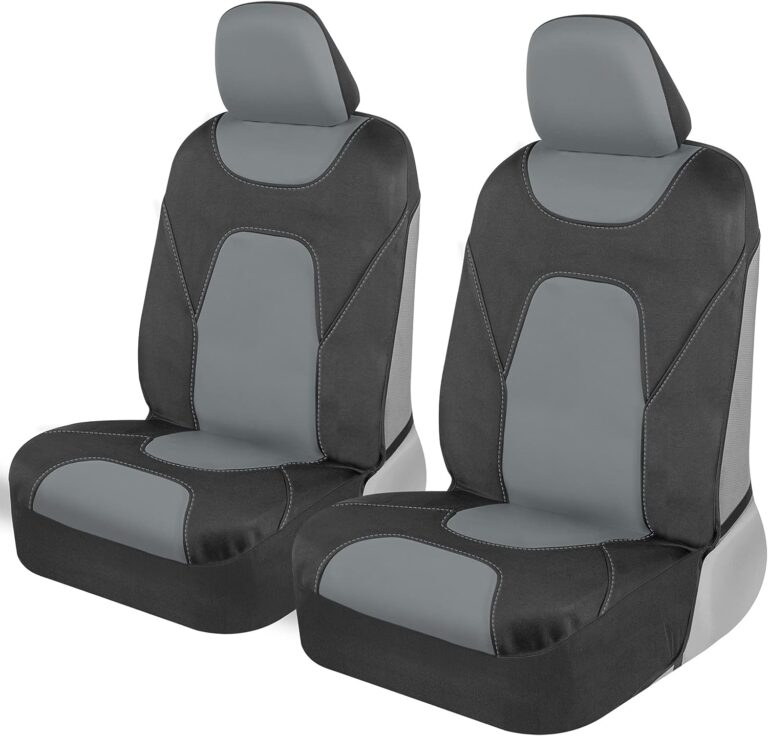Do You Sweat With Neoprene Seat Covers?
Yes, neoprene seat covers can cause sweating, as they are highly effective at trapping heat and moisture. When you sit on a neoprene seat cover, the material creates a barrier that prevents air circulation and increases your body heat, leading to sweating.
Neoprene is a synthetic rubber material that is commonly used for its water-resistant and insulating properties. It is often used in seat covers to protect against spills and stains and provide added comfort. However, this material’s insulating properties can also cause you to sweat, especially during hot weather or prolonged sitting.
If you tend to sweat excessively or are sensitive to heat, you may want to consider other seat cover options that offer better breathability and moisture-wicking properties.
Sweating And Neoprene Seat Covers: The Truth
Neoprene seat covers are popular for their durability and water-resistant properties. Many people wonder if they cause excessive sweating. The truth is, neoprene materials are known for their ability to trap heat, which can lead to increased perspiration. However, it’s important to understand the science behind sweating while seated.
Sweating is a natural bodily response that helps regulate body temperature. The body produces sweat to cool down when it becomes too hot. Neoprene seat covers can create a barrier that traps heat against the body, resulting in increased sweating.
Despite common misconceptions, sweating with neoprene seat covers doesn’t necessarily mean they are low quality or ineffective. It simply means that the material’s insulating properties are at work. If you’re concerned about excessive sweating, you may consider using seat covers made from breathable materials, such as mesh or cotton blends, which allow for better air circulation.
Understanding how neoprene seat covers affect sweating will help you make an informed decision when choosing seat covers for your vehicle.
Stay Cool And Dry Despite Neoprene
Neoprene seat covers are renowned for their durability and protection against spills and stains. However, many people wonder if they make you sweat excessively. The good news is that with advancements in material technology, neoprene seat covers are now designed to provide breathability and enhance airflow.
These innovative seat cover designs incorporate features that allow air to circulate, keeping you cool and dry even during hot summer days. The neoprene material itself is now engineered to be more breathable, preventing excess heat and moisture buildup.
If you’re looking to further enhance the cooling effect of neoprene seat covers, there are a few DIY tips you can try. One option is to use seat cushions with built-in ventilation or fans, which can help increase airflow. Another tip is to regularly clean your seat covers to prevent any sweat or dirt accumulation that could affect breathability.
With the right neoprene seat cover and a few cooling techniques, you can stay comfortable and sweat-free, even with neoprene seats.
Do You Sweat With Neoprene Seat Covers? Tackling The Heat
Neoprene seat covers have gained popularity for their durability and water-resistance, but many wonder if they make you sweat excessively. The key to managing body heat lies in understanding the material’s unique properties. Neoprene is known for its insulation, meaning it traps heat, which can lead to sweating. However, this material is also breathable, allowing moisture to escape.
Some people believe that adding ventilation holes or using cooling pads can reduce sweating, but in reality, these methods have mixed results. The most effective strategy for managing body heat is to ensure proper air circulation inside the car. This can be achieved by using built-in side airbags or air channels in the seat cover. Additionally, wearing breathable clothing and using seat covers with moisture-wicking properties can help keep you cool and dry.
Real-life experiences vary: some individuals report sweating more with neoprene seat covers, while others find them comfortable. To reduce sweating, use seat covers made with moisture-wicking fabric or those with innovative cooling technology. Proper maintenance, such as regular cleaning and airing out the seat covers, can also enhance comfort. Ultimately, finding the right balance between keeping your seats protected and managing body heat is key.
Accessories To Enhance Neoprene Comfort
Neoprene seat covers are a popular choice for car owners due to their durability and comfort. However, one common concern is the potential for excessive sweating when using neoprene seat covers. To address this issue, there are several accessories available that can enhance neoprene comfort and help reduce heat build-up.
One option is to use seat beads in combination with neoprene seat covers. Seat beads provide ventilation and air circulation, allowing heat to escape and keeping you cool and sweat-free during long drives.
In addition, there are seat cover add-ons specifically designed to reduce heat build-up. These add-ons typically feature mesh or perforated materials that promote airflow and prevent excessive sweating. By incorporating these accessories into your neoprene seat covers, you can enhance your comfort and minimize the risk of sweating.
It’s worth noting that car interior accessories play a significant role in temperature control. Aside from seat covers, consider investing in other accessories like sunshades, steering wheel covers, and seat cushions with temperature-regulating properties to create a more comfortable driving experience.
Preventative Measures For Neoprene Sweating
- Keep the seat covers clean by regularly wiping them down with a damp cloth.
- Avoid exposing the seat covers to direct sunlight for long periods of time, as this can cause excessive sweating.
- Use a breathable fabric seat cover underneath the neoprene cover to provide ventilation and reduce sweating.
- Avoid wearing heavy or thick clothing that can trap heat and moisture.
- Apply a thin layer of talcum powder on your skin before sitting on the neoprene seat cover to absorb excess moisture.
- Consider using a seat cover with built-in ventilation features, such as perforations or mesh panels.
- Regularly inspect the seat covers for any signs of wear or damage and replace them if necessary.
- Store the seat covers in a cool and dry place when not in use to prevent moisture buildup.
- Avoid using harsh detergents or abrasive cleaners when cleaning the seat covers, as this can damage the neoprene material.
- During hot summer months, consider using a seat cover with UV protection to prevent fading and excessive sweating.
- In colder weather, use a thermal seat cover or add an extra layer of insulation underneath the neoprene cover to keep warm and minimize sweating.
- Regularly check for moisture buildup underneath the seat covers, especially during rainy seasons, and ensure proper ventilation to prevent mold and mildew growth.
Smart Practices For Hygiene And Comfort
- Regularly wipe down the seat covers with a damp cloth to remove any surface dirt or sweat.
- Use a mild detergent or soap and water to gently scrub away any stains or odors.
- Avoid using harsh chemicals or abrasive cleaners that could damage the neoprene material.
- Allow the seat covers to air dry completely before placing them back on the seats.
- Staying hydrated is crucial to regulate body temperature and minimize excessive sweating.
- Wearing moisture-wicking clothing can help absorb and evaporate sweat, reducing discomfort.
- Choose breathable fabrics that allow air circulation to keep you cool and reduce sweat accumulation.
- Consider using a towel or seat liner in addition to neoprene seat covers for added absorption.
Post-use practices: Staying dry for the long haul:
- Remove the neoprene seat covers after use to prevent trapping sweat and moisture.
- Hang them in a well-ventilated area to dry completely and prevent mildew or mold growth.
- Inspect the seat covers regularly for any signs of damage or wear and replace as necessary.
- Consider using a seat cover protector to prolong the lifespan of your neoprene seat covers.
Frequently Asked Questions For Do You Sweat With Neoprene Seat Covers?
Do Neoprene Seat Covers Make You Sweat More?
Neoprene seat covers can cause increased sweating due to their insulating properties, trapping heat against the body. However, they are designed to wick away moisture and allow for ventilation, which can help reduce sweat buildup.
Are Neoprene Seat Covers Breathable?
Yes, neoprene seat covers are breathable. They are made with perforations or mesh panels that promote air circulation, allowing for better ventilation. This helps to reduce sweat buildup and keep you feeling comfortable during long drives.
Can Neoprene Seat Covers Be Used In Hot Climates?
Yes, neoprene seat covers can be used in hot climates. They are designed to withstand high temperatures and are UV resistant, preventing any damage or fading caused by the sun. The breathable nature of neoprene also helps to keep you cool in hot weather conditions.
Conclusion
Finding the right seat covers for your vehicle is crucial in enhancing comfort and protection. Neoprene seat covers offer many benefits, including durability and water resistance. However, it is essential to carefully consider your personal preferences and needs, as some individuals may find that neoprene seat covers can cause sweating.
By understanding the pros and cons, you can make an informed decision and find the perfect seat covers that suit your needs and lifestyle.
- Can I Get in a Taxi Without a Car Seat? - January 26, 2025
- Can I Get Chlamydia From a Toilet Seat? - January 26, 2025
- Can I Get an Uber With a Car Seat? - January 26, 2025






